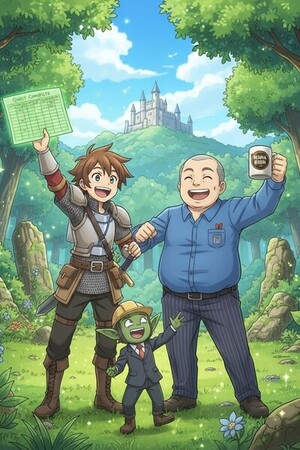Chapter 12:
Economic Ledger
Earthly Solutions
The transformation of our office into what Mr. Tanaka called a "comprehensive financial management center" was proceeding with the kind of systematic precision that would have made our old corporate overlords weep with envy. But it was his approach to client documentation that truly revealed the depths of his organizational obsession.
"Yamamoto," he announced one morning, gesturing toward what appeared to be the most elaborate filing system I'd ever seen, "I've completed the standardized record-keeping protocols for all adventuring party classifications."
I looked at the system he'd created, which consisted of color-coded ledger books, cross-referenced filing categories, and what appeared to be a custom inventory tracking methodology that would have been impressive in a Fortune 500 company, let alone a medieval fantasy setting.
"This is... comprehensive," I said, flipping through one of the ledger books, which contained detailed financial records for a [Human Warrior, Level 16] who had apparently been meticulously documenting his expenses down to individual arrows and ration portions.
"Comprehensive is the bare minimum," Mr. Tanaka replied, pulling out what appeared to be a standardized client intake form that was easily six pages long. "If we're going to optimize their financial management, we need complete data on their operational expenses, revenue streams, equipment depreciation schedules, and consumption patterns."
I examined the intake form, which asked for information with the kind of exhaustive detail that would have made an IRS audit seem casual by comparison.
"'Please provide the exact weight in kilograms of all ore harvested during the previous fiscal quarter, including classification by mineral type and estimated market value at time of acquisition'?" I read aloud. "Mr. Tanaka, do you really think adventurers are going to track this level of detail?"
"They are if they want our services," he said with the inflexible certainty of someone who had discovered the perfect system and refused to compromise on its implementation. "Accurate financial optimization requires accurate data. You can't manage what you don't measure."
He showed me a completed ledger for one of our existing clients—a [Dwarf Fighter, Level 14] who had apparently embraced Mr. Tanaka's documentation requirements with religious fervor.
"Look at this," Mr. Tanaka said proudly, pointing to meticulously recorded entries. "'Day 1: 3 healing potions consumed, 47 coins expense. 1 short sword damaged, depreciation value 23 coins. 2.3 kilograms Giant Toad eyeballs harvested, estimated market value 156 coins.' This is exactly the kind of detailed record-keeping that enables effective cost-benefit analysis."
I stared at the ledger entries, trying to process the image of a heavily armored dwarf carefully weighing Giant Toad eyeballs and recording their market value in a tiny notebook.
"And our clients are actually doing this?"
"In fact, they’re embracing it. Once they see how detailed documentation translates to increased profitability, they become as obsessive about record-keeping as I am about analysis."
He pulled out another ledger, this one belonging to a [Human Cleric, Level 13] whose expense tracking had apparently reached levels that bordered on the supernatural.
"'Divine focus crystal: 340 coins initial cost, projected 18-month useful life, monthly depreciation 18.9 coins. Holy water: 12 coins per flask, consumption rate 2.3 flasks per standard dungeon expedition, cost per quest 27.6 coins. Prayer beads: replacement cost 89 coins, average breakage rate 0.7 beads per month.'"
"They're calculating depreciation rates for prayer beads?"
"They're optimizing their operational efficiency through systematic expense analysis," Mr. Tanaka corrected. "And the results speak for themselves—this cleric has reduced his cost per quest by thirty-eight percent while increasing his effectiveness ratings through strategic resource allocation."
The numbers were impressive. But watching Mr. Tanaka's satisfaction as he described the minutiae of adventure accounting, I was beginning to suspect that he was enjoying the documentation process almost as much as the optimization results.
"Mr. Tanaka," I said carefully, "are you sure we're not making this more complicated than it needs to be?"
"Complicated?" He looked at me with the expression of someone who had just been accused of a fundamental misunderstanding. "Yamamoto, this isn't complicated, this is thorough. The difference between amateur financial management and professional optimization is exactly this kind of detailed analysis."
He gestured toward a wall chart that tracked what appeared to be the market prices for every conceivable item that could be found, sold, or consumed during an adventuring expedition.
"Giant Toad eyeballs: 67 coins per kilogram, seasonal variation of plus or minus 12 percent. Goblin ears: 23 coins per dozen, premium of 15 percent for undamaged specimens. Dragon scales: 450 coins per scale for red dragons, 380 coins for blue dragons, 290 coins for green dragons, with size classification affecting value by up to 40 percent."
"You've... you've created a comprehensive market analysis for monster parts?"
"I've created the foundation for accurate revenue forecasting and strategic quest selection," he said with pride. "When our clients know the exact market value of potential loot, they can make informed decisions about which expeditions offer the best risk-adjusted returns."
I looked around our office, which had evolved into something that resembled a cross between a medieval accounting firm and a fantasy economics research center. Charts covered the walls showing equipment depreciation curves, spell component price fluctuations, and what appeared to be seasonal demand patterns for various types of adventure-related services.
"How are our clients reacting to all this... documentation?"
"Mixed reactions initially," Mr. Tanaka admitted. "But once they see the results, they become converts. Look at this."
He pulled out a file containing what appeared to be testimonial letters from satisfied clients.
"'Dear Earthly Solutions LLC,'" he read, "'Thanks to your expense tracking system, I've increased my net income by 290 coins this month while reducing my operational costs by 18 percent. I never realized how much money I was losing to inefficient inventory management. —Marcus, Level 15 Warrior.'"
"Okay, that's actually pretty compelling."
"There's more. 'Your equipment depreciation schedules have revolutionized my gear replacement strategy. Instead of buying new weapons reactively when my old ones broke, I now plan replacements based on predicted failure rates and can negotiate better prices through advance purchasing. —Erika, Level 12 Rogue.'"
I had to acknowledge that the results were speaking for themselves. Whatever skepticism I had about Mr. Tanaka's obsessive documentation requirements, our clients were clearly benefiting from the systematic approach.
"But surely not everyone is embracing this level of detail?"
Mr. Tanaka's expression darkened slightly. "We've had some... resistance. Particularly from higher-level adventurers who consider detailed record-keeping beneath their dignity."
"Such as?"
"A [Human Paladin, Level 19] told me that 'true heroes don't reduce their noble quests to mere accounting exercises.' A [Human Berserker, Level 22] said that 'warriors who count coins instead of counting victories have lost their souls.'"
"And how did you respond?"
"I pointed out that proper financial management would allow them to afford better equipment, take more challenging quests, and achieve greater heroic accomplishments through superior resource allocation." He paused. "They were not receptive to this argument."
I could imagine that conversation had not gone well.
"But for every high-level adventurer who rejects our methods," Mr. Tanaka continued, "we gain three mid-level adventurers who recognize the practical value of professional financial management. And honestly? The mid-level market is more profitable anyway."
"How so?"
"High-level adventurers tend to have established patterns and significant ego investment in their current approaches. Mid-level adventurers are still building their careers and are much more open to optimization strategies that can accelerate their professional development."
He showed me a client analysis chart that broke down our customer base by level, profitability, and growth potential.
"Our sweet spot is [Level 10-16] adventurers who have enough experience to understand complex financial concepts but haven't yet become rigidly attached to inefficient practices. They're also at the career stage where marginal improvements in efficiency can have dramatic impacts on long-term wealth accumulation."
I studied his analysis, which was surprisingly sophisticated for someone who had been in the consulting business for less than three weeks.
"You've really thought this through."
"Yamamoto, I've discovered that I genuinely love this work. Not just the financial analysis—though that's incredibly satisfying—but the process of helping people understand and optimize their economic situations." He gestured around our office with obvious pride. "For the first time in my career, my obsession with detailed documentation is actually helping people instead of just satisfying bureaucratic requirements."
I looked at him, noting the way his entire demeanor had changed since we'd started the business. The anxious, constantly stressed corporate drone had been replaced by someone who was genuinely excited about his work.
"Think we can maintain this level of service as we scale up?"
"Not just maintain," Mr. Tanaka said with confidence. "Improve. Every client we serve teaches us something new about fantasy world economics. Every documentation system we implement makes us more efficient at helping the next client. We're not just building a business—we're developing expertise that becomes more valuable with every consultation."
As I watched him return to his ledger books with the enthusiasm of someone who had found his true calling, I realized that our interdimensional transportation had accomplished something remarkable: it had turned a miserable corporate accountant into a passionate entrepreneur who was genuinely making people's lives better.
Even if those people now had to weigh their Giant Toad eyeballs with obsessive precision.




Please sign in to leave a comment.